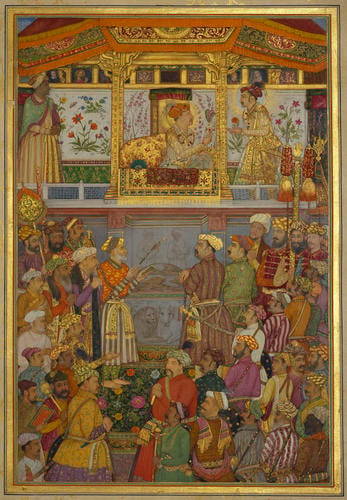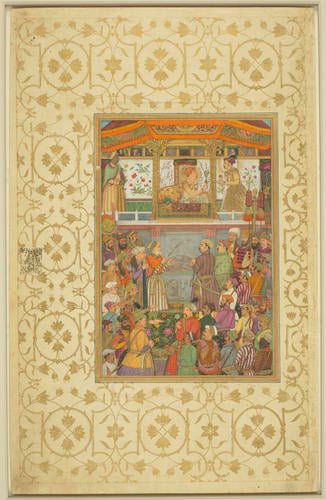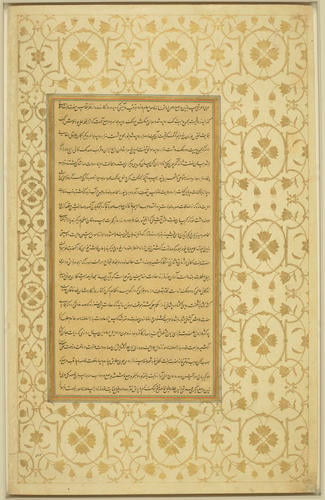-
1 of 253523 objects
Jahangir presents Shah-Jahan with a turban ornament (12 October 1617) c. 1635-50
Painting in opaque watercolour including metallic paints. | 30.6 x 21.3 cm (image) | RCIN 1005025.an

Payag
Master: Padshahnamah پادشاهنامه (The Book of Emperors) Item: Jahangir presents Shah-Jahan with a turban ornament (12 October 1617) c. 1635-50

Payag
Master: Padshahnamah پادشاهنامه (The Book of Emperors) Item: Jahangir presents Shah-Jahan with a turban ornament (12 October 1617) c. 1635-50

Payag
Master: Padshahnamah پادشاهنامه (The Book of Emperors) Item: Jahangir presents Shah-Jahan with a turban ornament (12 October 1617) c. 1635-50



-
Padshahnamah fol. 195r
(plate 39)
Jahangir presents Shah-Jahan with a turban ornament in the Hall of Public Audience at Malwa, in Mandu, on 30 November 1617.
A month after Emperor Jahangir awarded his son the title Shah-Jahan (‘King of the World’) in recognition of his military triumph in the Deccan, he gave him a jewel worn his grandfather Akbar that Jahangir had worn throughout his reign as a good luck charm. Here, the jewel, set into a plumed turban ornament, symbolising the future transmission of power of Jahangir to Shah-Jahan. The presence of Bijapuri courtiers at the bottom right of the scene reference Shah-Jahan’s recent victory.
Painted in grisaille under the jharoka balcony is an allegorical image in three parts: at the centre is a globe on top of which stand two mullahs with a lion and an ox lying side by side below. This is a reference to both Emperors’ projecting themselves as benign universal sovereigns, expressed through their titles Jahangir (‘World-Seizer’) and Shah-Jahan (‘King of the World’). Mirza Ghiyas Beg, Jahangir’s father in-law and Shah-Jahan’s grandfather, gestures towards the mullahs representing spiritual authority. One holds the imperial sword, and the other an open book that reads ‘may the lifetime of the state be perpetually extended’. Mir Muhammad Baqir, an important minister, gestures to the cow and the lion lying together, symbolising sulh-i kul, ‘universal harmony’, under beneficent Mughal rule. This image is adapted from the title page of the Polyglot Bible, where it symbolises Messianic peace prophesied in the eleventh book of Isaiah, a copy of which was brought to the Mughal court by the Jesuits in 1580.
The figure on the lower left edge of the painting holding a folder and wearing a fashionable Turkish textile of a wavy tiger-stripe design is a self-portrait of the artist. The inscription on his folder reads ‘God is great! Drawn by Payag, brother of Balchand’, which may suggest that his brother, the painter Balchand, was the better known of the two when this work was painted.Bibliography:
Milo Beach and Ebba Koch, King of the world : the Padshahnama, an imperial Mughal manuscript from the Royal Library, Windsor Castle, 1996
Saqib Baburi, Beyond the Akbarnamah: Padshahnamahs and Official Regnal Chronography for Shah-Jahan Padshah (r. 1037/1628-1068/1658), 2010.Provenance
Illustration from a Padshahnamah manuscript formerly in the Mughal imperial library and acquired by Asaf al-Dawlah, Nawab of Awadh, c.1780-90; presented by Saadat Ali Khan, Nawab of Awadh, to George III via Lord Teignmouth in June 1799.
-
Creator(s)
(illustrator)Acquirer(s)
-
Medium and techniques
Painting in opaque watercolour including metallic paints.
Measurements
30.6 x 21.3 cm (image)
58.3 x 36.8 cm (page dimensions)
Category
Alternative title(s)
Jahangir presents Prince Khurram with a turban ornament (12 October 1617)